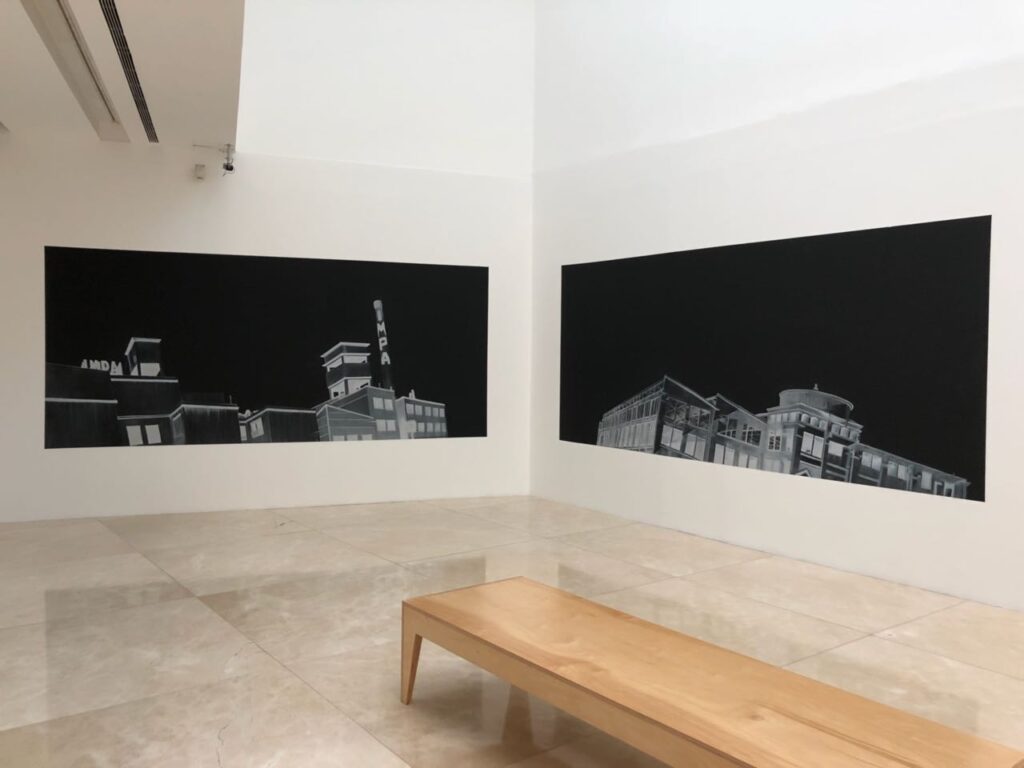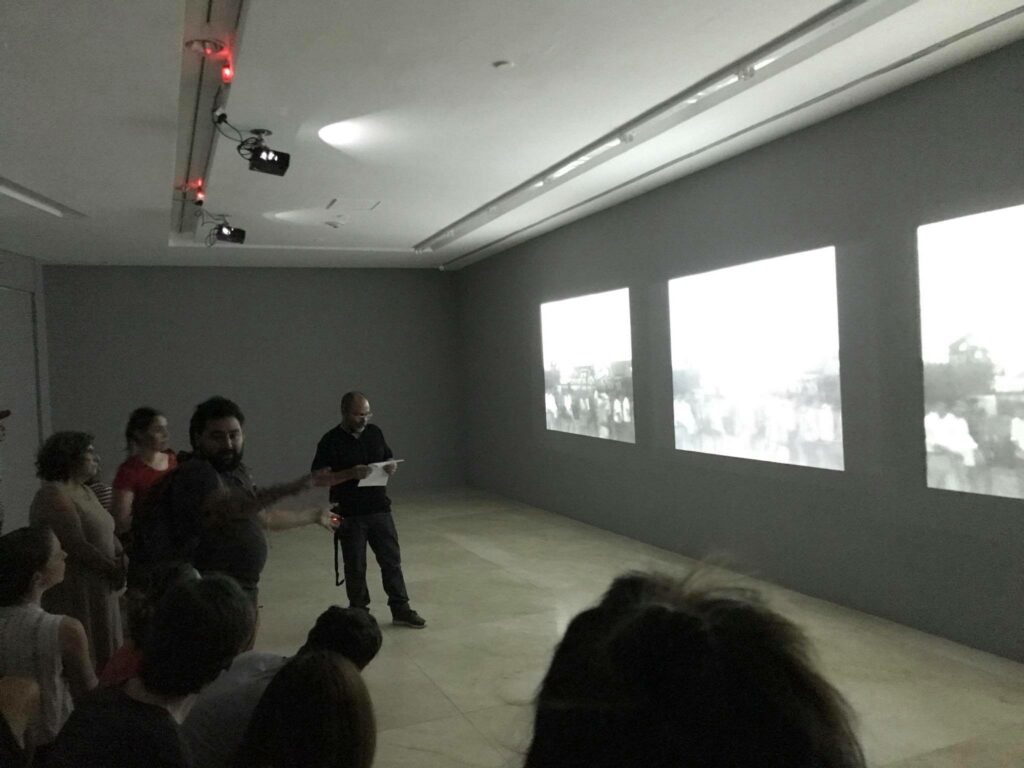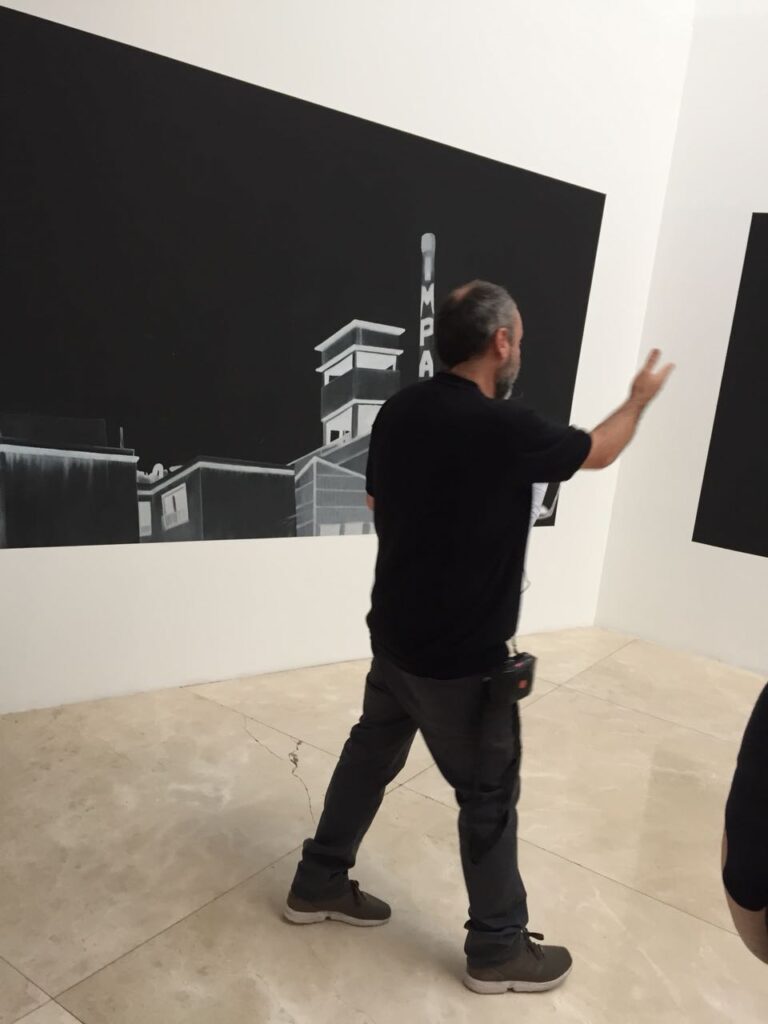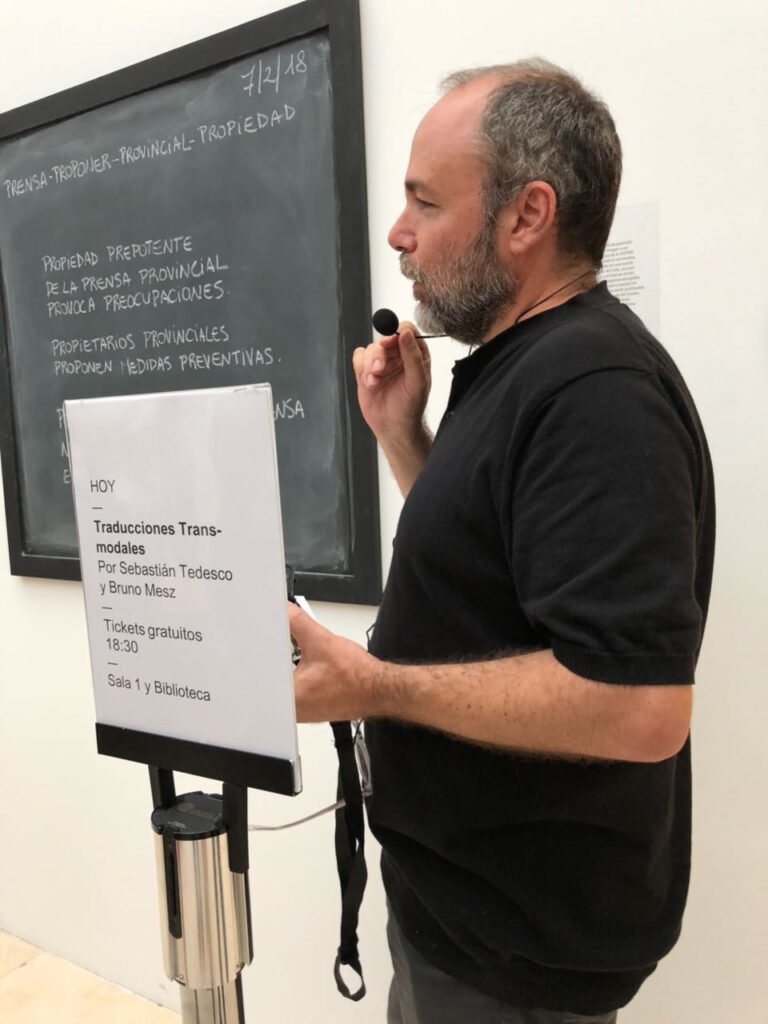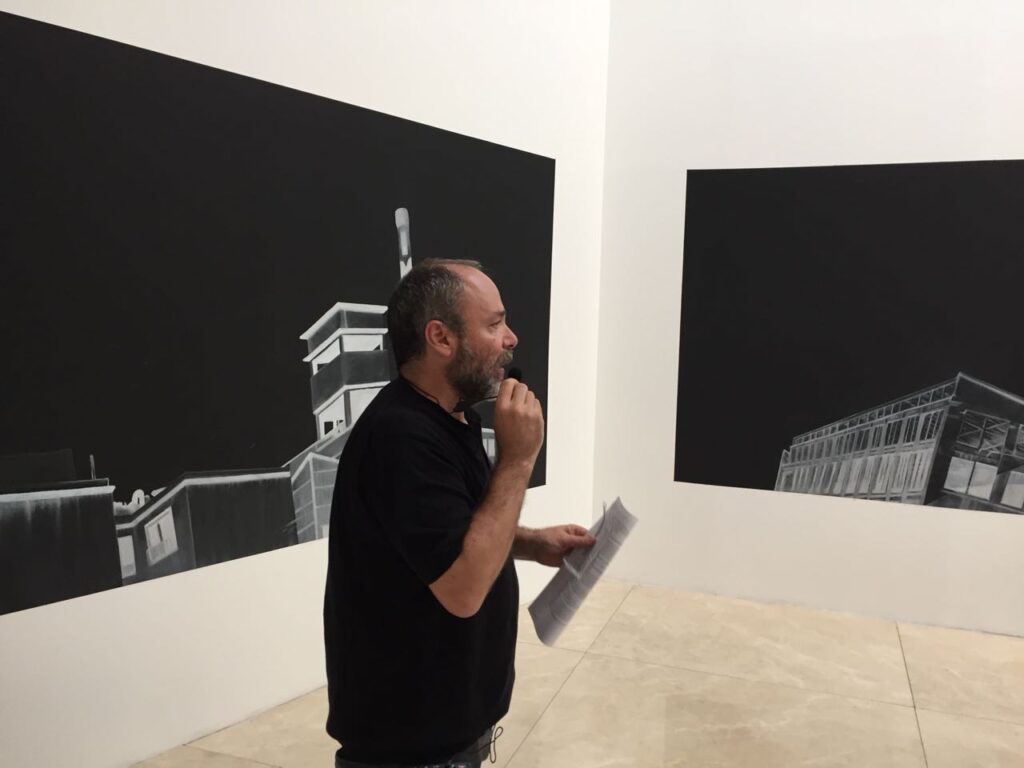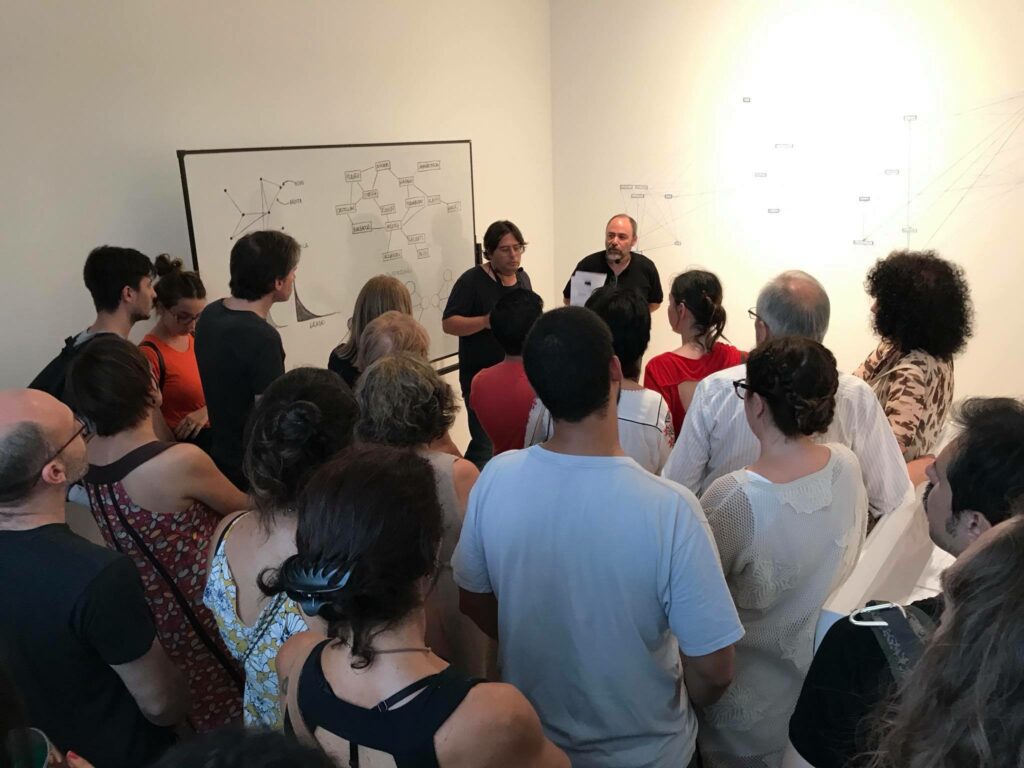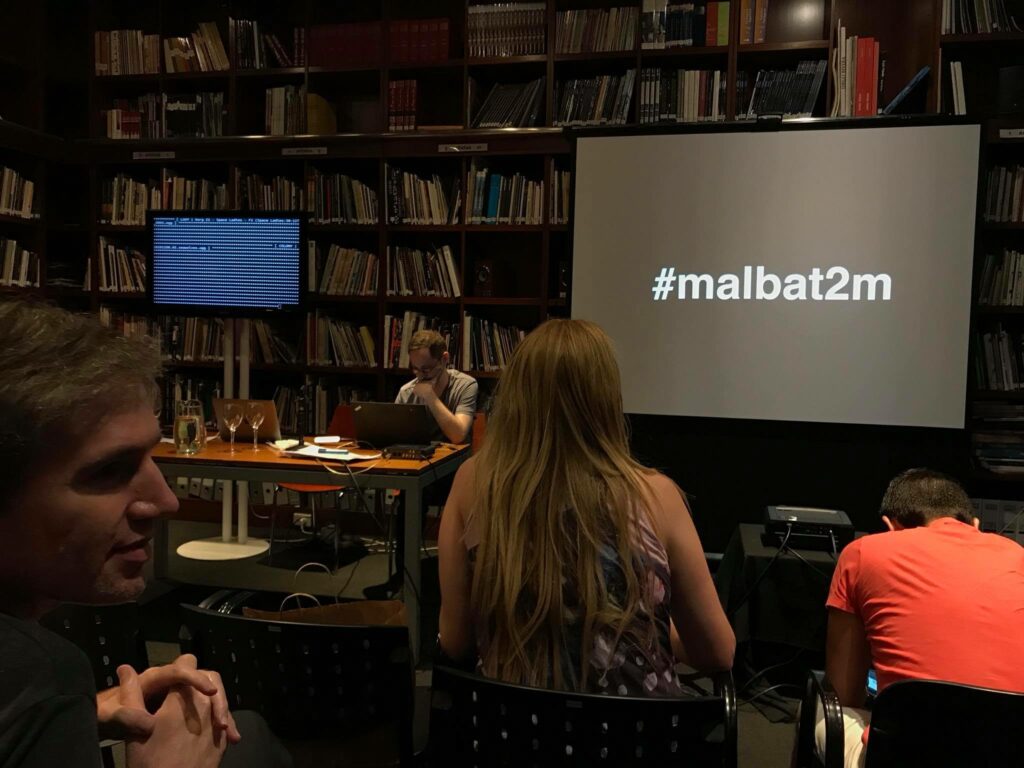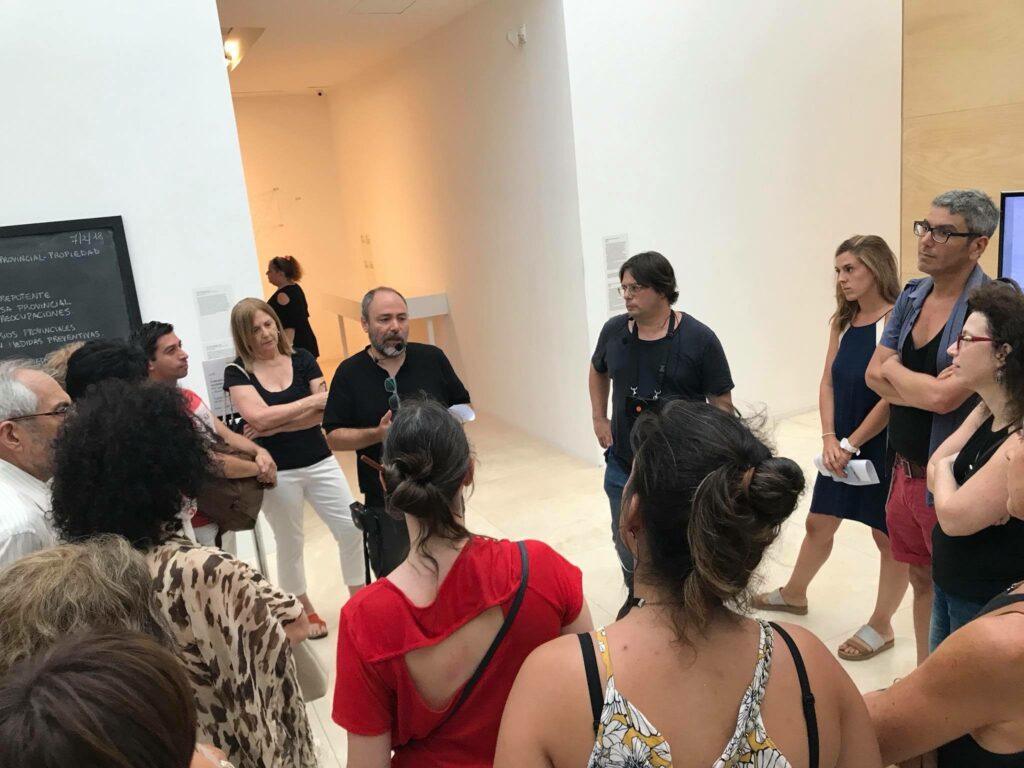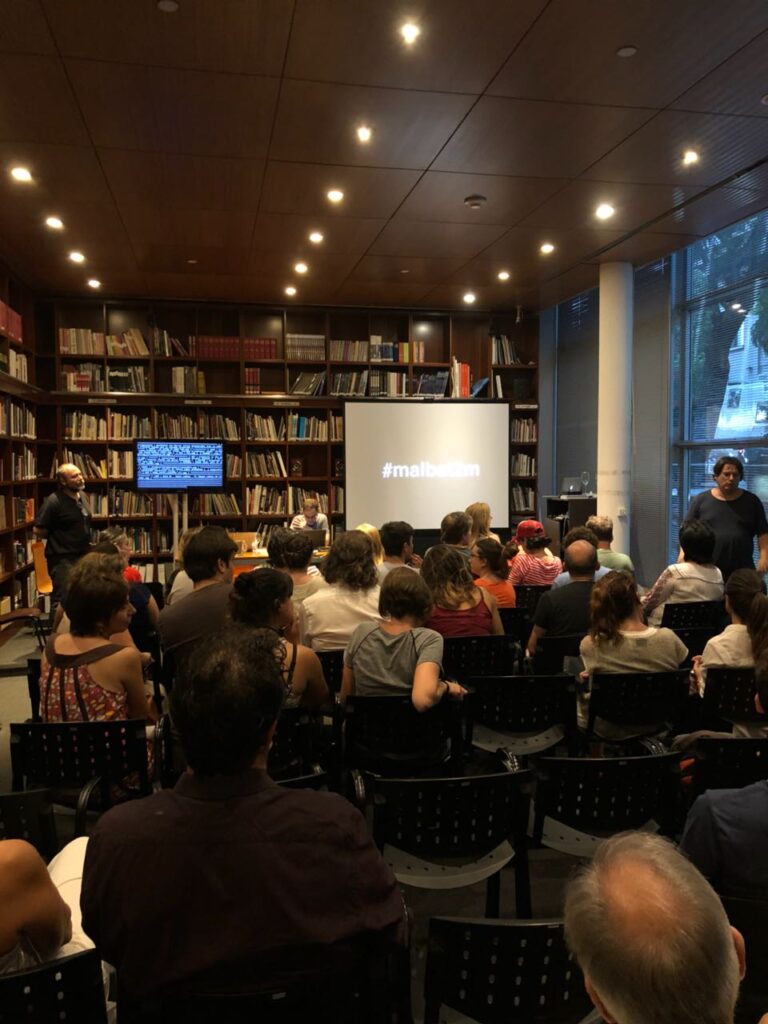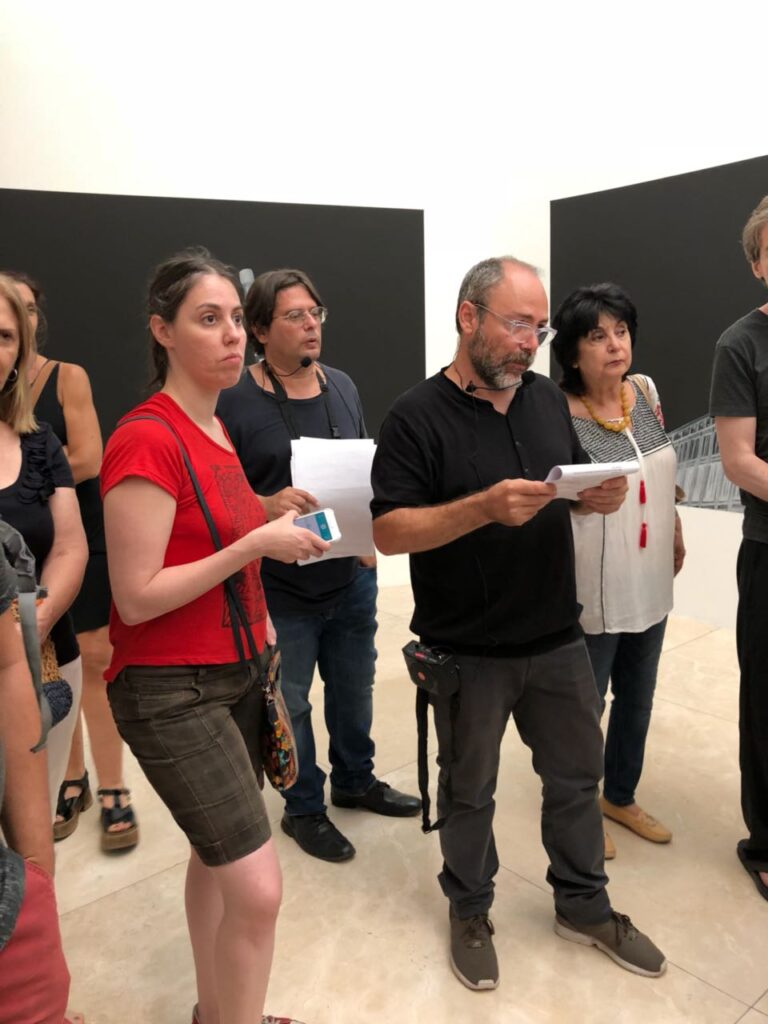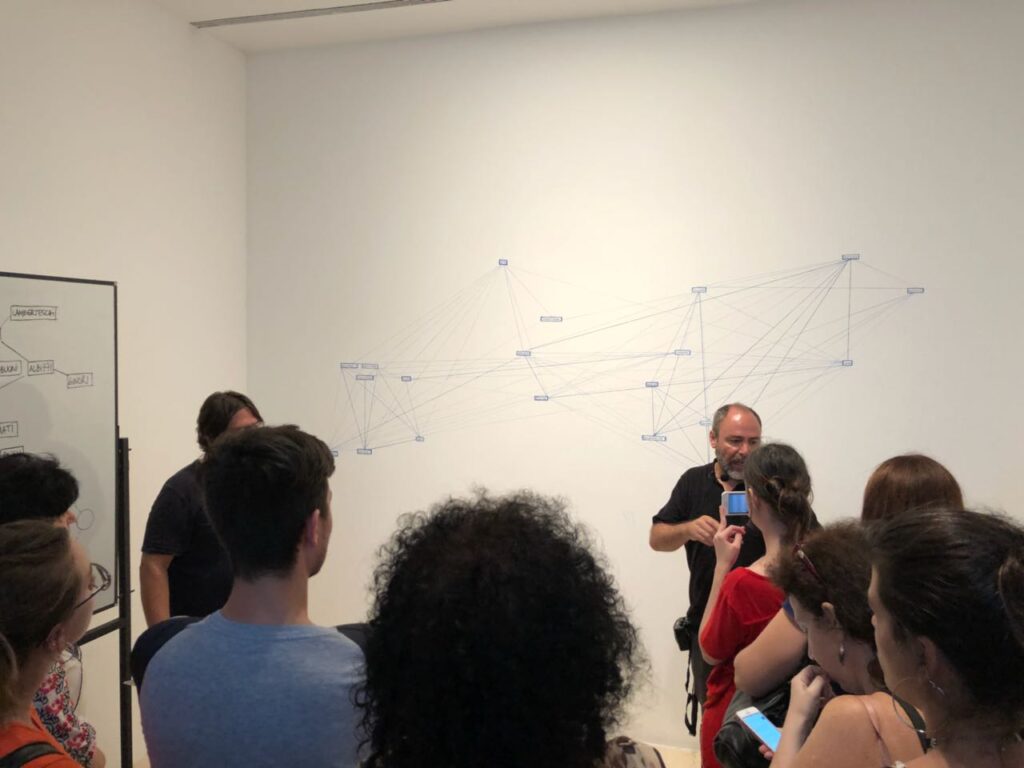12.01.2017– 02.12.2018
Curators: Agustín Pérez Rubio and Diana Wechsler.
MALBA, Sala 1.
Mathematical strategies development that were used to carry out a translation and interpretation of the text of Tucumán Arde from the theory of graphs and information theory for the development of the visual pieces of the sample. Joint project with Bruno Mesz.
Departure of the museum workers. Taller y República from Tucumán Arde, by the Venezuelan artist Alexander Apóstol (Barquisimeto, 1969) was an exhibition project specially developed for MALBA and co-produced with BIENALSUR. Apóstol proposes an open and collective discussion on the relations between art and politics, based on a contemporary reworking of the Tucumán arde manifesto: can a discussion be raised today based on production and dissemination strategies similar to those of that time?
“In Latin America, art and politics historically constituted two interdependent variables. The most prominent artistic movements in the region contributed to promoting new ways of conceiving political discussion and facilitating its insertion into the social network. Among them, Tucumán Arde (1968) is remembered as one of the most important aesthetic-political actions carried out in our environment “, explain the curators Agustín Pérez Rubio and Diana Wechsler. “This project – they add – consists of bringing that experience to the present through its founding text. Based on different work strategies, Apóstol raises an open and collective discussion on the structure, format, reproduction and relevance of a political art project apparently far from the circumstances from which it emerged. The Tucumán Arde manifesto function here as an analysis tool that allows addressing issues such as the artist’s training, his role as an author, and the socio-political insertion of the work. “
Apóstol deconstructs the manifesto from a mathematical breakdown carried out in collaboration with Bruno Mesz and Sebastián Tedesco, and transfers its structure to numerical codes through the Graph Theorem, heir from historical mathematical problems that privilege the routes and processes over the endings or results and closely linked to geometric disciplines that propose a change of vision about objects: they define them by their properties and not by their shapes. This theorem, moreover, is the natural scheme of social networks and shows the character of the movement in question. Thus, based on certain linguistic relationships in the manifesto, a numerical sequence is obtained which, in various workshops, will be translated into other formats by specialists and UNTREF students: a film installation with archive material intervened with animation techniques; a series of tweets written under a specific metric structure; a video performance made by salaried workers from Malba and BienalSur; two blackboards with drawings of emblematic Argentine factories run in politically opposite ways. The production cicle involved in these work groups brings the scope of the interpretation and dissemination of a discourse from the mutating limits of art authorship. Finally, all the resulting activity will be replicated in the networks as a unifying and enhancing space for the entire exercise.
Operative scheme of the Graphos Theory
Artists that participated in Tucumán Arde managed to develop strategies for production and dissemination of works thanks to the formation of a work network, a social network. At the same time, they went on a geographical tour and established links with artists, peasants, trade unionists, etc., mainly in Rosario, Buenos Aires and Tucumán. On one hand, their manifesto denounced the tensions between the employer / government and the peasant / worker within the framework of a dictatorship, and, on the other, affirmed the need to break with the cultural system in pursuit for the creation of a revolutionary art produced outside institutions and focused on education. In this project, that manifesto is deconstructed through a mathematical algorithm originated by Damián H. Zanette and Marcelo A. Montemurro to be later reconstructed in various workshops. From the Information Theory, the grammatical structure of the text is broken down into numerical figures that are later illustrated according to the Graphos Theorem.
In this sense, and as a metaphor for the work network developed by the artists of that movement, the Graphos Theorem operates as a suggestive dissection scheme that re-signifies the content of the text. From this theory arises, among other things, the functioning matrix of social networks and their based on relationships, processes and routes type of functionality.
Works
Huelga y contexto: patrón numeral, 2017
[Strike and context: numeral pattern, 201]
5-channel installation
16mm converted to HD video
Duration: 7 ’15 “
Various archive images on the sugar mills of Tucumán are grouped together in a film that talks about the landscape, the assembly, the harvest, the surveillance, the workers, the mill and the strike. The video is projected simultaneously on 5 channels, and is intervened with analog animations that operate independently on each channel. The animated interventions are based on the Tucumán Arde manifesto, dissected into 5 of its coefficients: Frequency, Asortivity (r), Grades, Sparseness and Clustering. The resulting numerical patterns allow a rewriting of the text to be introduced into the film through a basic vocabulary of animations, made by hand by 5 students.
The intervened film operates as an exercise in seriality or historical repetition, both of the worker’s conditions and their context and of the demands expressed in the manifesto.
20 Palabras significativas en azul – Manifiesto Tucumán Arde, 2017
[20 Meaningful words in blue – Manifesto of Tucumán Arde, 2017]
Blue graphite drawing on wall
Drawing in blue graphite on facsimile pages of the “Tucumán Arde” manifesto
By joining the 4 facsimiles of the typed text of the Tucumán Arde manifesto, we made a list with the 20 most significant words. These words are not those that translate the experience of the text, but rather those that involve the greatest number of possible connections, those that function as communicating nodes between the different sections or paths of the text.
Tucumán desde la izquierda, arde desde la derecha, 2017
[Tucumán from the left, burns from the right, 201]
Drawing with white checker on paper
The typescript of the Tucumán Arde manifesto is divided vertically, into two equal parts (left and right), with the white correction used in the past for typing corrections. Each fragment resignifies its own content and proposes a poetic one. From the division, the 20 most significant words on each side are established, starting from the first two words of the title. As a result of this operation, the degrees of inclination corresponding to the two slates are obtained Fabrica from a left incline, Fabrica from a right incline.
Tuits y Trapecios, 2017
[Tweets and Traps, 2017]
Blackboard with weekly tweets written in chalk
The 20 words resulting from the partitioning procedure of the founding text of Tucumán Arde were delivered to a group of 40 creative writing students from UNTREF. They wrote a daily tweet taking 4 words a week, and the words of each one were alternated in a kind of exquisite corpse. In total, 80 tweets were made, one for each day that the exhibition project lasted, and at the end they were joined consecutively in a general text. The chosen words were repeated in a cascade, creating a poetic text based on repetition and seriality. Two weekly tweets were posted on a blackboard in the room. Simultaneously, on the museum’s website, each tweet was numerically coded to establish, through its degrees of inclination, a geometric shape that was published daily.
Fábrica desde una inclinación a la izquierda.
Fábrica desde una inclinación a la derecha, 2017
[Factory from a tilt to the left.
Factory from a tilt to the right, 2017]
Drawing on blackboard
The typewritten manifesto of Tucumán Arde is divided vertically into two halves (left and right), and from each side the mathematical figure of the “random walk” is established. This algorithm selects 20 words along each side of the text. From this numerical result, the degree of inclination of the original photographs from the web of two factories in Buenos Aires is obtained, whose administrative organization and political function are antagonistic. The metal and plastic factory IMPA, recovered by its workers in recent years, established a horizontal organization for its staff and develops activities whose social function can be associated with the discourses of the traditional left.
The Campomar factory, abandoned for some years, had a traditional top-down organization, and is currently being investigated for the alleged relationship with the military dictatorship (1976-1983) and collaboration in the disappearance of its own workers.
[26 workers exit the frame, 2017]
HD video Duration: 17 ‘
The archive image that begins the film shows a group of 26 sugar workers during the 1966 Tucumán crisis.
The Tucumán Arde manifesto (1968), which emerged as a result of that conflict, advocated the defense of workers through works and artistic actions produced outside of cultural circuits. The artists who signed it considered that the museum, and cultural institutions in general, were not the appropriate place for the political and social demands of a revolutionary art. However, his legacy, currently legitimized, is studied and disseminated within the museum system.
Through a numerical exercise, the 26 words with the highest frequency of appearance in the text were taken, to be represented by the same number of cultural workers involved in the project. In a performance recorded in the same exhibition room, the salaried workers of the two organizing institutions of the project (Malba and Bienalsur) leave the frame according to the frequency that corresponds to them within their numeral classification.
The works demands and demands achieved by social or proletariat movements are absorbed by the cultural system through its workers. On many occasions, the study and dissemination of works with a marked character policy made from cultural institutions ends up deactivating, to a large extent, these demands.
Presentation
Cross-modal translates
by Sebastián Tedesco and Bruno Mesz
Wednesday, february 7th. Sala 1 and Library.
Bruno Mesz and Sebastian Tedesco, mathematicians and artists who worked together with Alexánder Apóstol on the site-specific project for Malba, propose a journey through the mathematical “B-side” of the exhibition, to replace, through a conference and a trans- sensorial in the concepts of trans-modal translations present in his works.
The activity includes a brief guided tour of the exhibition, which will take into account the mathematical mechanisms –Graph theory and Information theory– that were used to carry out a translation and interpretation of the Tucumán Arde text, and then a talk about the works and research carried out in the Aromatorio project at MUNTREF Centro de Arte y Ciencia.
In addition, in the context of the activity, they will present to the public the work “T2M”, made together with Lucas Samaruga, which explores the trans-modal correspondences and translations between aroma, text and sound
Alexander Apóstol
Venezuela, 1969
Conceptual multimedia artist who works on Latin American political history through the perspective of urban planning and architecture. He studied Art History at the Central University of Venezuela and photography at the Ricardo Armas School. His work includes photographs, films, installations and texts. He has been part of Manifesta 9, CAPC Bordeaux (2015) and of the Venice Biennials (2011), Prague (2003 and 2005); Cuenca (2004); Istanbul (2003), San Pablo (2002) and Havana (1997); Printemps de Septembre in Toulouse (2003); PhotoEspaña in Madrid (2003); FotoFest in Houston (2002), among many others.
